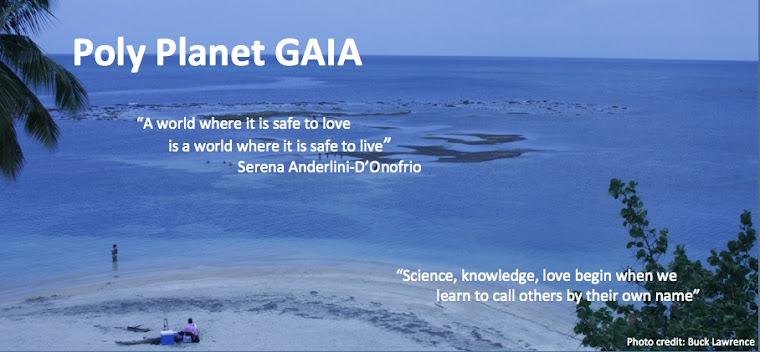Bisexual Epistemologies: A Journey from Nausea to Commitment
An occasional piece by
Serena Anderlini-D’Onofrio, PhD
For The Journal of Bisexuality’s 10th Anniversary Issue
Hi dear readers!
This seven-in-one piece will be great fun--yours truly promises. Find out all the ins and outs of 10 years of Bisexuality! What does "epistemology"mean? Big word, right? Well, all it means is that when you're making love you're producing knowledge. A good thing!
We follow The Issues with What Wisdom Accrued to Me? and will have one more post. Really revealing of all those things about bi you've always been curious about. Why is it so good? What can it do for you? For the planet? For the future? For authentic intimacy? It's all here, spiced with a bit of irony and critique of why we're so behind on our agenda. What's keeping us from being more efficient.
Also arcane words you've been told have no meaning unless you got a PhD are explained--made very easy! "Nausea," "existentialism": it's all about the chakra system--really. Commitment? It's not about going to jail (as in, "being committed"). But rather, it's about "being-in-action" about things. Being the one who makes the difference! No mysteries. Woooooow! Come back for more, will you? We'll post every week, on Tuesdays.
Namaste,
Serena
6. What Wisdom Accrued to Me?
As a guest editor with a transcultural, interlinguistic, and transdisciplinary perspective, I have endeavored to unfold the discourse of bisexuality to include voices that introduced ideas capable of expanding one’s thinking about this multifaceted trope well beyond what’s commonly understood. I have enjoyed the privilege of having enough space to publish articles that really make a difference, that present arguments complex enough and articulate enough and profound enough to be likely to have a role in the paradigmatic shift the third planet is going though with all of us in it, toward knowledge based on love.
This blank page, this slate without definition has been empowering to me, both as an editor and as a contributor. There have been no word limits to the length of a piece--just its own organic completion. No indirect censorship based on assumptions of what is and is not appropriate or correct in a given discursive arena. Pure invention guided by insight and intuition with wide ranging knowledge and reading. As an author whose literary initiation took place in Europe, I have a bit of an auteur syndrome. I like to be free. No Hayes Codes applied to my creativity. My inspiration has been honored here. And I have really felt like this is my cup of tea.
My contributions have been hosted with the highest respect for their originality and uniqueness. I tend to respect New Criticism because its practice of direct reading empowers students of literature to respond with their own emotional intelligence, rather than with surrogate constructs preapproved by their teachers. However, I believe that everything is political, including, of course--and perhaps most of all--literature, and other visual arts that have been the object of my analysis on these pages, including cinema. By “political” I mean embedded in a web of cultural and discursive practices related to geography, history, the sex/gender system, the race/class system, and other politically charged dynamics. However, I tend to write about texts that inspire me. As a scholar activist, I would not waste my time on something I don’t have the highest respect for. Therefore, I write against the grain of being “critical,” of attacking a piece. Sometimes people think I’m stupid, because I don’t dissect something I critique. The things is, I am a peace activist even when I practice literary criticism, therefore dissecting is not my cup of tea. I’d call my method of literary and cultural criticism “holistic.” Why? Because it integrates all the different approaches into a whole. My piece on Lillian Hellman in the Women and Bisexuality issue is perhaps the most exemplar of this (87-116). It is extremely political, as it dissects the lie of calling this inspiring author a liar, just because her political allegiances were against the grain of McCarthyism and the bipolar politics of the Cold War period. Yet it also goes very deeply into the textual analysis of two texts by this author, to access the bisexual aspect of the author’s erotic fantasies that inspired them. Obviously, this requires discussion of texts, contexts, biography, history, social, gender, and racial dynamics as an integrated whole. When this piece found hospitality in these pages, it had been rejected a number of times for doing its job too well. “Why does the author focus so much on the texts?” peer-reviewers wondered in cultural studies journals not aware of bisexuality’s existence. “Doesn’t she know we want what’s ‘political’?” In those discursive arenas, it was believed that close reading and cultural criticism could not get along. The Journal of Bisexuality knew better than this. This is the time to acknowledge its respect for my skills. The Journal also hosted two articles on film. There too, my attention was devoted to auteur films in the European tradition that paid special attention to bisexuality as an element of sustainability in relational patterns that involved several participants. These include Hamam and The Ignorant Fairies (a.k.a. His Secret Life), by Ferzan Ozpetek, and French Twist, by Josiane Balasko. It is often said that only negative representations of bisexuality are visible in film. This might apply to Hollywood film production. However, in the films I chose bisexuality is a factor for inclusion in amorous communities and expansion of the ways in which love can be practiced therein. These articles appeared in 2005 issue (now the book Plural Loves) and 2010 (Bisexuality and Queer Theory). I am grateful that they could be included in integrity with their holistic intent.
Yours truly appreciates your attention. Stay tuned for more wonders.
Namaste,
Serena Anderlini-D'Onofrio, PhD
Gilf Gaia Extraordinaire
University of Puerto Rico, Mayaguez
Follow us in the social media














